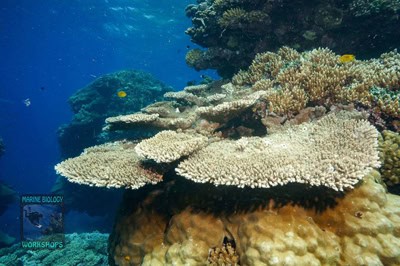
Submitted by Stephan Moldzio, Reef Check EcoDiver Course Director
Red Sea Diving Safari’s next Reef Check EcoDiver course will take place in Marsa Nakari, Egypt July 18-21, 2024, with five subsequent surveys from July 22-25. Spaces are available for both certified Reef Check EcoDivers, and divers who would like to be trained and certified as EcoDivers.
2023 marked the 15th year of Red Sea Diving Safari’s reef monitoring program, which took place in Marsa Shagra from July 13-16, 2023. We had six course participants and for the subsequent surveys, six already-certified EcoDivers who had completed the course in previous years joined us. They had timed their stay specifically to take part in the surveys.
As experienced Reef Checkers, they not only helped with the data collection, but also with laying out and collecting the two transect lines. We were a large and varied team, with participants ranging from 12 to 69 years old, from Open Water Diver to Master Instructor. We had great dives and a very eventful time together.
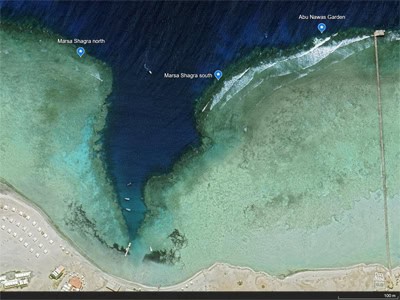
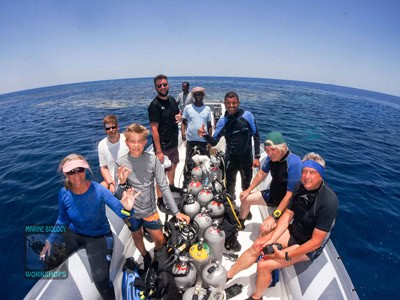
Reef Check EcoDiver Course and Surveys
Theory sessions and practical dives alternated during the Reef Check EcoDiver course. Participants first learned about the Reef Check method and the different indicator groups of fish, invertebrates & human impacts, as well as substrate (coral, algae, reef rock, sand, etc.). On each day of the course, we conducted two training dives on the reef to practice identifying indicators and using underwater hand signals. On the third day, the practical application of the Reef Check method was practiced on land along the transect line during a beach exercise.
Once all the participants had successfully completed the tests to identify the indicator organisms, they were certified as Reef Check EcoDivers. When it came time for a test survey on the final day, it was clear to all participants that it was time to get serious!
We had planned Reef Check surveys at five different reefs. With two 100 m transect lines, we were able to set the transects for both depths simultaneously. The survey teams were also able to complete both depths in one dive, first at 8.5 m and then at 3.5 m.
About our results:
The substrate team found an average hard coral cover of 49.5% across all five survey sites and both depths. Marsa Shagra North had the highest value with 65.0% at 3.5 m depth and 43.1% at 8.5 m depth.
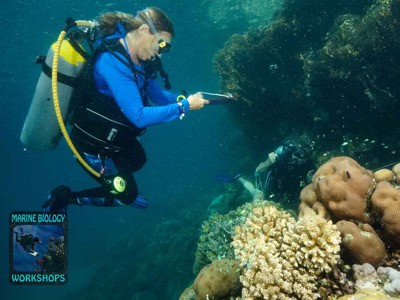
In this area, the reef slope is a little shallower and not so steep, so there is more light at the deeper levels and therefore more coral growth.
For giant clams, the difference between the shallow and deeper levels was particularly evident. This is because giant clams also have symbiotic algae in their mantle lobes and therefore prefer light-flooded, shallowly sloping reef slopes.
The only other invertebrates we found during our surveys were a few pencil urchins, banded coral shrimps and, at Wadi Lahami, a large crown-of-thorns starfish (Acanthaster planci).
The `Invertebrate and Human Impacts team´ looked very carefully in all the caves and crevices during the surveys since most invertebrates hide during the day from the many predators. However, during our night dives we found the full spectrum of invertebrates who only emerged from the reef caves at night.
For groupers, which are an important indicator of overfishing, we found by far the most groupers larger than 30 cm at Marsa Shagra North with 1.75 individuals per 500 m³ transect. Specimens smaller than 30 cm are not counted in the Reef Check method.
In addition to more than 30 years of consistent protection, the extraordinary width of the reef flat around Marsa Shagra contributes to the abundance of fish and high species diversity.
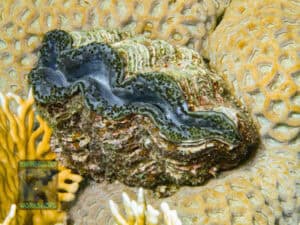
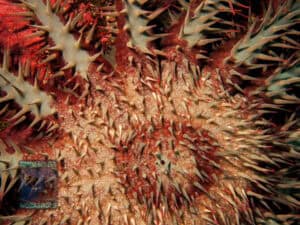
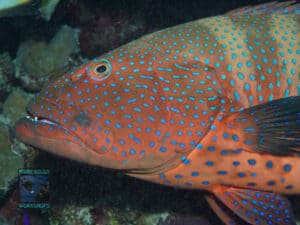
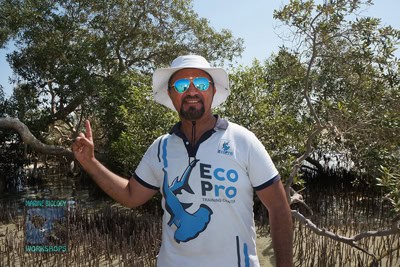
Tour through Wadi El Gemal National Park
We then headed to Wadi Lahami for two more surveys. The normal two-hour bus journey passes through the Wadi El Gemal National Park (WGNP). We turned it into a national park tour with stops at selected locations.
Our long-time friend, marine biologist Dr. Ahmed M. Shawky, who also participated in the Marsa Shagra surveys, guided us through the National Park, explaining the natural features at each stop.
Dr. Shawky has worked for the WGNP rangers for many years and knows the park ‘like his own backyard’. This allowed us to experience the fantastic nature and scenery, as well as the Egyptian culture and way of life of the Bedouin who live here.
At our first stop, right at the start of Wadi El Gemal National Park, we visited Roman ruins and a large umbrella acacia (Vachellia tortilis).
Ras Baghdadi is the remnant of a once mighty river, also known as the Wadi El Gemal Delta. The river pebbles washed down from the mountains bear witness to much wetter times many thousands of years ago. Today, the wadi (= dried riverbed) only carries water during floods, which occur every few years. Despite this, the groundwater allows the local vegetation to flourish, with doum palms (Hyphaene thebaica), date palms (Phoenix dactylifera), Nile tamarisk (Tamarix nilotica) and many other plant species. A pond with common reed (Phragmites australis) provides fresh water for many animals.

The last stop was at El Qulan. Here we had the opportunity to enjoy a traditional Egyptian coffee, the “Gabbana”, with the Ababda Bedouins. It is very strong and refined with cardamom, cinnamon, cloves, pimento, nutmeg and pepper.
We then explored the large mangrove area: the white mangrove (Avicennia marina), with its aerial roots, is the only mangrove species in the Red Sea that is adapted to the dryness and high salinity. Typical inhabitants of the mangroves are the land hermit crab (Coenobita scaevola) and various other crabs. They dig tunnels in the sandy soil and build conical “castles”.
In the evening, Dr. Shawky gave a talk on dolphins in the Red Sea, offering interesting insights into their behavior and social life, their nocturnal hunting and interaction with their only predators- the large tiger sharks and oceanic whitetip sharks.
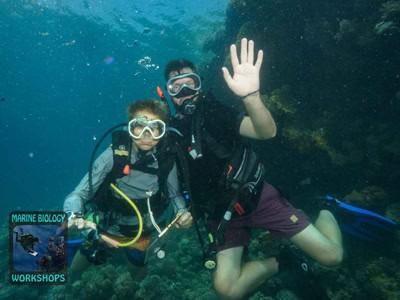
Wadi Lahami & Fury Shoals
After our last two surveys at Wadi Lahami house reef, we were able to dive the fantastic reefs of the Fury Shoals. While the offshore reefs of “Angel” and “Malahy” boast epic reef formations, nearby “Daisy” captivated us with its nutrient-rich conditions, abundance of fish, and lush coral growth.
In addition to the more common species, these reefs are home to the rare hooded butterflyfish (Chaetodon larvatus) and the endemic Red Sea longnose filefish (Oxymonacanthus halli). Both species feed exclusively on coral polyps and are therefore dependent on areas of dense coral cover.
A big thank you goes out to Red Sea Diving Safari for all their support and great cooperation!
The next Reef Check course will take place in Marsa Nakari, July 18-21 2024, with five subsequent surveys from July 22-25.
Are you interested in learning more about the diversity of coral reefs and taking part in reef surveys to collect scientific data? Send us an email at info@marinebiologyworkshops.de
More information at: https://www.greencorals.de/en/reef-check-2/
 Subscribe to Newsletter
Subscribe to Newsletter Donate
Donate Shop
Shop 0
0









